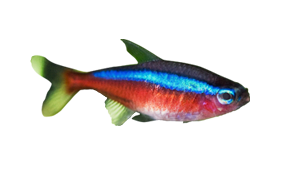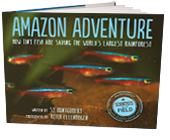Amazon Adventure: How Tiny Fish Are Saving the World’s Largest Rainforest
(Scientists in the Field Series)
HMH Books for Young Readers, ISBN 978-0544352995
Chapter 1: Little Fishes, Giant Jungle
It’s the planet’s richest ecosystem, where a butterfly’s wing can grow as big as your hand, and five hundred species, from frogs to insects, can be found on a single flower. The Amazon basin—the 2,670,000 square miles drained by the Amazon river and its many tributaries—is the world’s largest jungle, an area as big as the lower forty-eight U.S. states, the size of the face of the full moon. Jaguars hunt in the shade of 200-foot tall trees; pink dolphins, who the local people claim have magic powers, swim in the rivers. New species discovered here in the last decade include a tarantula striped like a tiger, a bald parrot, a vegetarian piranha, and a monkey who purrs like a kitten.

This huge, ancient rainforest is essential to the planet. Because its trees provide a full fifth of the world’s oxygen, it’s called “the lungs of the world.” Yet it all could vanish—and soon. Each year, mining, clear-cutting, burning, and cattle ranching destroy an area of Amazon forest twice the size of the city of Los Angeles.
Luckily, beneath the rivers’ glassy surface live dozens of species of tiny, beautiful fish whose powers may be even greater than the mysterious pink dolphin’s or the mighty jaguar’s. These shy fish—so small the locals call them all “piaba,” (pee-AH-bah) which roughly translates to “small fry” or “pipsqueak”—just might be able to save the Amazon.
How? We’re on our way to find out.
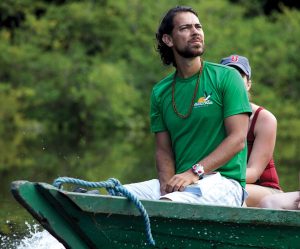
We’re traveling by riverboat from the port of Manaus up Brazil’s Rio Negro, one of the two main arteries that join to form the Amazon River. Our destination, 307 miles to the north, is Barcelos, a town of 20,000. Each year, fishermen come here from miles around, bringing some 40 million of these small, colorful tropical fish caught in their forest communities. From Barcelos, the fish will be shipped to Manaus, and from there to public and home aquarium tanks around the world.
But wait: Capturing and exporting wild animals from their natural habitat sounds like a terrible idea—doesn’t it?
Our host, Scott Dowd, agrees. “That’s exactly what I thought when I first came here,” he explains from aboard the deck of our boat, the MV Dorinha. A big man with a silvery beard and twinkling blue eyes, Scott knows better now. Today, eagerly admits, “I couldn’t have been more wrong!”
Scott vividly recalls his first trip up the Rio Negro. It was 1991. He was twenty-four years old, and had teamed up with a prominent professor at the Brazilian University of Amazonas, Dr. Ning Labbish Chao, to charter a boat with ten other fish enthusiasts. He was thrilled to be in the green heart of the rainforest. He loved watching red and yellow macaws streak across the sky; he loved sleeping in a hammock on the boat at night and waking to the growling roars of howler monkeys in the morning. But mainly he came for the fish.
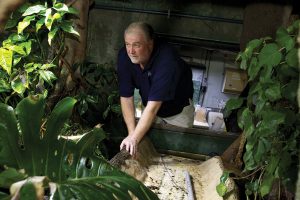
Today, Scott is Senior Aquarist with the New England Aquarium in Boston, in charge of 12,000 fish, frogs, snakes and turtles in its Freshwater Gallery. He’s always been, as he puts it, a “fish nerd.” He started keeping fish tanks before he was ten. And like just about any kid who keeps a freshwater fish tank, many of his first pet fish were species native to the tea-colored waters of the Rio Negro.
The river water here is stained dark from tannins—natural chemicals that come from plants whose leaves fall into these pure waters. The tannins make the water acidic. “The waters are pristine—but it’s a hard place to make a living if you’re a fish,” Scott says. Adapting to the difficult conditions here has sculpted beautiful and bizarre fish: Cardinal tetras, who glow with neon stripes of electric red and hyacinth blue. Marble hatchet fish, who can fly out of the water to escape predators. Splash tetras, who spawn on the wet undersides of overhanging tree leaves to keep their eggs safe. (The male lurks below in the water and throws water up at the eggs with his fins for days to keep them moist.) Scott could not wait to visit Barcelos, the town from which so many of the fish he had kept as a child and tended at the New England Aquarium had come.
But when his group finally got there, Scott was horrified. The riverfront was jammed with men in dugout and plank canoes. They had come from an area of rainforest the size of Pennsylvania, bringing hand-woven, plastic-lined baskets full of living fish. They would fill hundreds of eight-gallon tubs, each containing 800 fish—so many that they covered the entire bottom floor of the 80-foot-long ferry docked at the pier, heading to Manaus.
“My kneejerk reaction was, this is out of control!” Scott remembers. “I thought, we shouldn’t be taking wildlife from the rainforest; we should be farming them!”
But back then, he says, he didn’t realize what would happen if the fishermen just left these fish alone.
In the Amazon rainforest, there are only two seasons: wet and dry. During the wet season, which peaks during North America’s winter, it rains every day, and the forest floods. Trees stand up to their crowns in water. People build houses on stilts, or on pontoons so they can float. Kids don’t take a bus to school—they take a boat. Then, in the dry season, which peaks during our summer, the water level drops—sometimes more than thirty feet. Nearly ninety percent of the small fishes here are stranded, doomed in drying puddles.
It’s at the start of the dry season when most of the fishing for piaba takes place. For the fish who are captured, it’s like a rescue operation. A cardinal tetra, one of the most popular piaba species, would be lucky to live a year in the wild. In a home aquarium, a cardinal might live to two, three, or more.
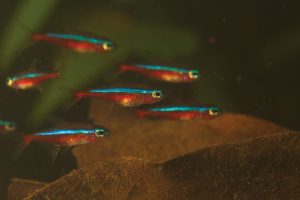
“This has got to be the world’s most benign fishery,” Scott explains. The fishers, known locally as piabeiros (pee-uh-BEAR-ohs), work from canoes, urging the fish into big, hand-held nets and then scooping them gently from the water into their waiting plastic-lined baskets with gourds or buckets. And what about other species, scooped up by accident? In many other fisheries—like in Scott’s native New England—unwanted fish, called bycatch, “mostly die on the boat,” he says. “But here, they’re released immediately and exactly where they were living.” It’s easy for the piabeiros to release unwanted fish; unlike aboard a big trawler, in their handmade canoes, the water is only inches away.
The little fish bring such high prices at the market that the trade in aquarium fishes in Barcelos provides sixty percent of the cash income for 40,000 people, most of whom live in a vast jungle of 46,000 square miles. Piaba might mean “small fry”—but to be a piabeiro is a Big Deal. Think of it: at your local pet store, a cardinal tetra, who weighs only half a gram (.017 oz), might cost $4-$6. Do the math: There are 1,000 grams in a kilo, and .45 kilos in a pound. Cardinal tetras are worth around $8,000 per kilo, or $3,600 per pound! Sold as treasured pets, these little fish provide far more profits than do fishes who are captured and killed for people to eat. In fact, pound per pound, these fish are as precious as the rubies and sapphires whose colors they share.
The local people recognize that piaba “are the most valuable thing they have,” says Scott. “Piabeiros and their families protect their river and the forest that surrounds it like their lives depend on it—because they do.” In other areas of the Amazon basin, people desperate for jobs might welcome timber barons, cattle ranches or mining interests. But here, they’re not welcome. Piabeiros know these industries would pollute their waters with silt, dung or toxic metals. The fishery for the aquarium trade, Scott understood after his 1991 visit, “serves as a very effective first line of defense for the rainforest.”
“Not only is the fishery not out of control,” Scott realized. “Here we have harmony between humans and the environment in one of the most biologically important places in the world. It’s not just a sustainable fishery; it’s beneficial. This is paradise saved!”
After returning from that eye-opening expedition, “we had the feeling we’d made a major discovery in the Amazon,” Scott says. “Not gold, or new tribes”—but a different treasure trove: beautiful, small fish who could save the rainforest.
Across the Amazon basin, some 400 different species of freshwater fish are collected for the aquarium trade. This trade, properly managed, could well provide an “environmentally and socially responsible” alternative to destructive timber extraction, mining and slash and burn agriculture. That’s the conclusion of a 2005 convention held in Colombia, organized by World Wildlife Fund-South America and Traffic, the international wildlife trade monitoring group and attended by experts from Ecuador, Venezuela, Colombia, Peru, Brazil and Guyana.
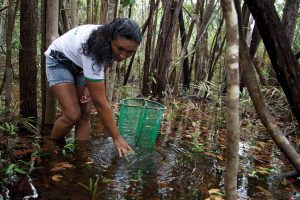
Now, we’re going to see for ourselves. Scott and his Brazilian counterpart, economist Mari Balsan, have gathered a group of forty-five people, enough to fill two big boats, on an expedition up the Rio Negro. Some are scientists. Some are professional aquarists like Scott. Some sell aquarium fish for a living. Some are fish veterinarians. Some are home hobbyists. Some are students. Some are volunteers. Scott’s wife, Tania, who heads the New England Aquarium’s Sustainable Seafood Program, is here too, along with their kids, Daniel, four and Theo, seven. I’ve come to write this book for you, along with photographer Keith Ellenbogen, who takes the pictures.
We’ve all come to see some of the fish species that many of us kept in our aquariums as kids, living in their natural, wild environment. We’ve come to meet the piabeiros. We hope to learn from them how this kind of fishery might help protect other watery environments on continents around the world. We’ve timed our trip to coincide with a local celebration, the Festival of Ornamental Fishes, with songs and dances, floats and fireworks, sure to be a highlight of the journey to Barcelos.
But we’ve also come to consider some of the piabeiros’ problems, and try to help. Even back in 1991, Scott realized that the piabieros’ sustainable fishery faced some serious problems. Some of the fish collected from the Amazon were arriving at aquariums stressed and sick from their journey. Meanwhile, competing business interests were trying to figure out how to force cardinals and other piaba to spawn in captivity, which could be sold cheaply. That could wipe out the piaberos livelihood—and force them to turn to mining, forest-destroying farming, or even selling drugs.
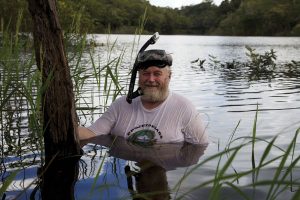
That’s why Scott and his first collaborator, Professor Chao (now retired from the project) founded Project Piaba: to provide the piabeiros with support and advice from fish scientists, veterinarians, industry advocates, and policy advisors, to help both the piaba and the piabeiros thrive. With the slogan “Buy a Fish, Save a Tree,” Project Piaba aims to connect hobbyists and professional aquarists around the world with the people who provide their fish. Together, they can help support the health of the jungle environment that the fish, the piabeiros, and more than a thousand other species—including our own—depend on to survive.
Scott comes back to the Amazon year after year, learning new things each time. But this year, the expedition has special urgency. Today, he warns, threats to this fishery—some from well-meaning people, others from competing business interests—are more serious than ever. They could undermine not only the local people’s livelihoods and culture, but endanger the Amazon itself.
